Avatar: Frontiers of Pandora is an open-world first-person adventure. It has a particular emphasis on combat and exploration, with a healthy mixture of platform-puzzle solving, basic survival gameplay, and light role-playing game mechanics. It is, for all intents and purposes, Far Cry with Blue Cat Alien People and Neon Flora… but it is also so much more.
Thanks to their long-standing, island-hopping and dictator-heavy franchise, Far Cry, Ubisoft have technically set the standard for open-world gameplay and exploration. If this were Far Cry 7, and not a game based on James Cameron’s Avatar licence, it would most assuredly be the best Far Cry to date. This is thanks in large part to the amount of additions and changes it brings to the classic Ubisoft open world formula. It goes without saying, however, how the game has a few very high hurdles to clear, and it does so almost effortlessly.
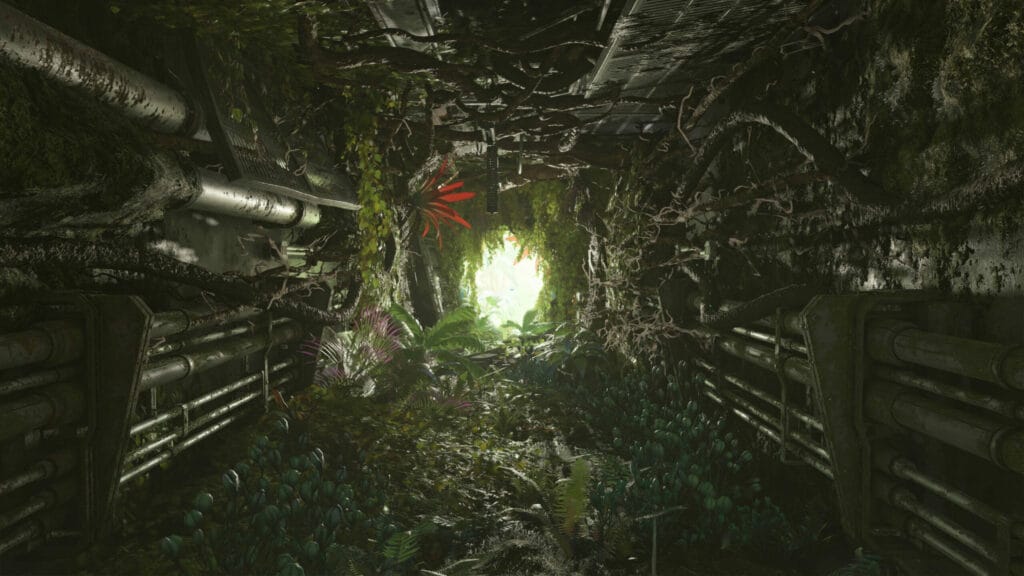
Movie tie-ins and video games based on blockbuster film franchises tend to be cursed. Long-gone are the days where classic tie-ins like Blade and Tarzan would grace the massive monoliths that were our parents’ CRT monitors – simpler times where sparser narratives still afforded as much fun and excitement as the movies these titles were based on. Instead, we live in an era of high-octane hits like Cyberpunk 2077, Gears of War, and The Last of Us; where adventuring means being shepherded from one area to another or one checkpoint to the next, with constant story beats, narrative twists, and high-fidelity eye candy. Plots are often written by award-winning writers and overworked development studios eventually get the upper hand by delivering masterpiece upon masterpiece that hardly, if ever, rely on additional outside expectations – such as films – to get sales figures out of the door. This is where Avatar: Frontiers of Pandora hopes to make its bed, promising an experience unlike anything video gamers have experienced before, in a world decidedly alien and foreign; yet also based on the ideas present within a roaringly successful film franchise. With all of the above in mind, the joint development of the game between Massive Entertainment, Ubisoft Shanghai & Düsseldorf, and FoxNet; have mostly hit it out of the ballpark.
Avatar: Frontiers of Pandora brings the big-screen franchise to life on the interactive front. The player-character (a fully customisable ‘avatar‘) comes from a group of Na’Vi who were abducted by the RDA at a young age in order to serve as the link between two worlds: Na’Vi, moulded and taught Human values. The events of James Cameron’s first Avatar film acts as the catalyst for the narrative in the game, but chronologically it takes place closer to the same time period as the second film, with the player-character and their friends being sealed in cryo for the better part of two centuries after the initial tutorial level. Once woken up and presented with a newfound “freedom”, it is up to the player and their friends to discover what being Na’Vi means, and how much the RDA have truly taken away from the native peoples of Pandora. While loading takes a while to get going, once in the world, players can expect an almost seamless experience, which falls beautifully into place as the events of the game slowly unfold. Massive Entertainment have spent some quality time with the same folks who are bringing Avatar to the big screen. The result? A lengthy, albeit epic, 15-hour story spanning Pandora and taking players to parts of the world the movies have yet to touch upon.
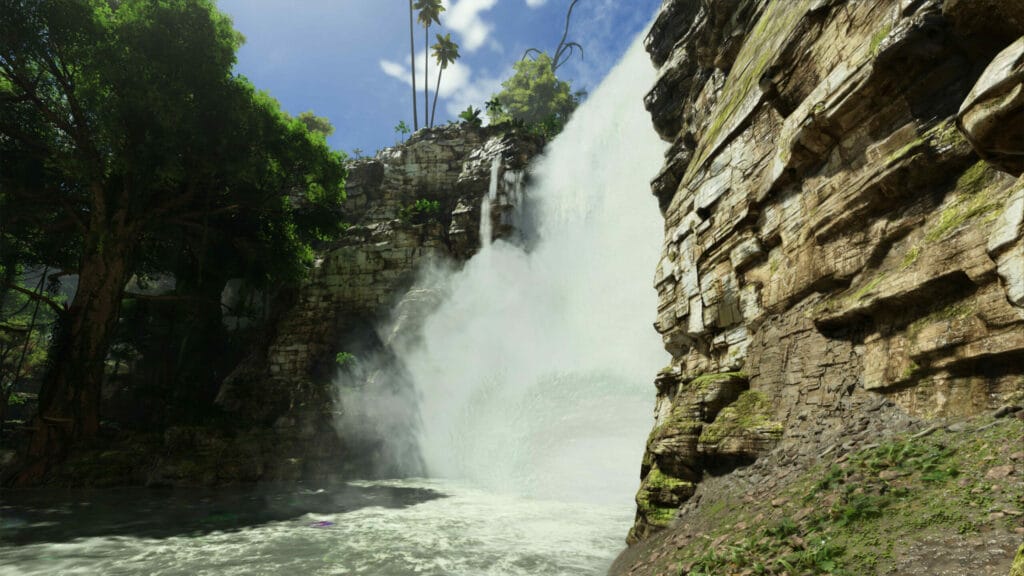
Despite it being a video game based on a film franchise, Avatar: Frontiers of Pandora does not have an imbalance regarding gameplay and narrative. Instead, the game allows players to experience as much or as little as they want of the game while slowly taking them through the various beautiful biomes the open world has to offer. During this time, players will find themselves hunting from the shadows or forest canopy, disabling various RDA installations, foraging and gathering food and resources, and crafting new gear to stay in the fight. In short: the scope and variety offered within Avatar: Frontiers of Pandora is out of this world, and once players complete a quest called Take Flight (and unlock mounts), the words “Frontiers of Pandora” suddenly make so much more sense.
Thanks to the unique nature of the player-character and their RDA teachings while young, the player-character can make use of human weapons and technology. This includes a scanner-like device used to hack and repair wires, various weaponry, and even, when the plot dictates, other human machinery. These, along with gear native to the Na’Vi, allows players to take out all sorts of enemies and wildlife in order to survive Pandora. Much of the gameplay attributed to combat will have Far Cry fans feeling cosy and comfortable, with little to no real changes in this aspect. Where the game does feel different, however, is in the way the game presents itself. The user interface is incredibly minimal, while gameplay elements such as healing, finding ancestor trees and upgrading skills, all tie into the narrative like some beautiful epic poem ebbing and flowing through the beautiful subject matter.
While accessibility is not as robust as other games releasing in the same window, Avatar: Frontiers of Pandora allows users to tweak and fine tune almost all aspects of the experience. This includes toggles for walking modes, switches to turn some UI elements completely off or make them brighter and bolder, and more. The amount of player freedom in this respect is nice to see. With that said, something that could be changed is the duration of how quickly everything crashes down on the player as the game begins. The entirety of the first two hours are either spent giving players exposition on the world and the characters around them, or teaching players how the seemingly hundreds of different gameplay mechanics all fit into the bigger picture. Needless to say, this is overwhelming and has the potential to turn gamers off of experiencing the wonders the game has to offer down the line. An approach akin to Hogwarts Legacy, with content spread over a few hours of gameplay, could have been more beneficial.
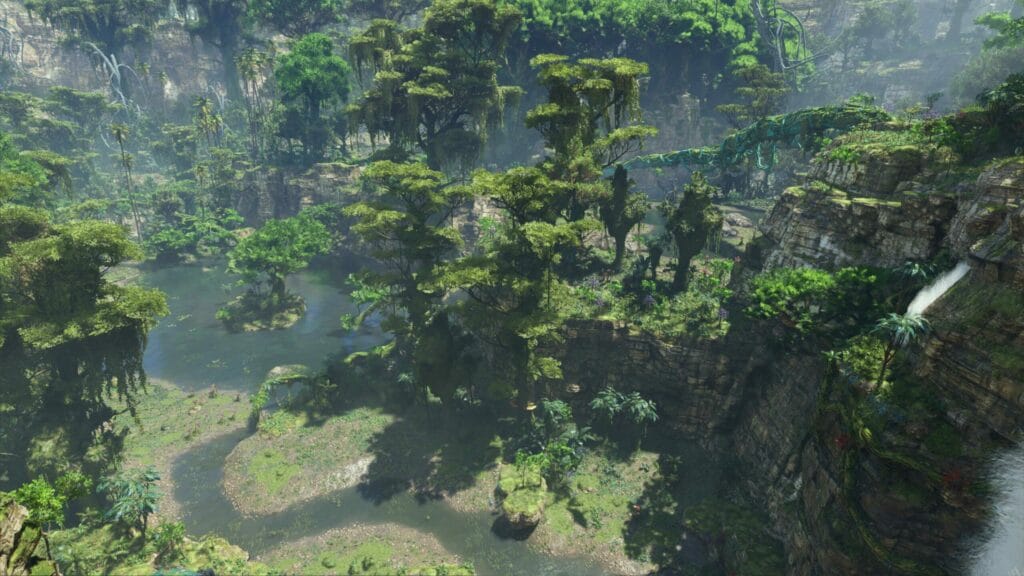
Learning about the Na’Vi and about Na’Vi history closely ties into unlocking “Ancestor Skills”, an additional tree of abilities removed from the normal skill tree and its five gameplay-based branches of gathering, stats, stealth, combat, and piloting. Similarly, learning more about the land, its fauna and flora, and even all of the enemies players will encounter, all boils down to using Na’Vi sense (a Witcher Sense-like viewing mode) and pressing an inspect button. In turn, all of the subject’s secrets [such as how to best remove a twig from a tree, or a bulb from a bush] will be revealed in lengthy lore entries found within the Hunter’s Guide. Furthermore, players can also tame animals!
Whether the four-legged Direhorse, or the flying Ikran, players will go through a cool ritual-type experience the first time they tame and bond with both, and also learn about how best to approach the animals to begin with. Once tamed, however, calling upon either land or aerial mount is a matter of pressing a button… but be warned, these mounts do not just appear from behind some offscreen rock; they actually make their way to the player. This means players need to ensure that dropping from a particularly high tree or off a cliff will still allow the Ikran ample time to get to the player before they splat onto the ground. Pro Tip: just do not go anywhere without them!
On the topic of flight, however, it needs to be noted how traversing the skies is an absolute treat. Flying around Pandora not only amounts to incredible enjoyment, but also a kind of freedom Ubisoft titles have never really catered for in previous games. There are no real restrictions of where players can and cannot go once on their Ikran’s back, and the skilltree related to the mounts ensures every new flight after a level will feel fresh and exhilarating. It also helps how the developers have nailed down the controls, resulting in solid and unparalleled flight; but why even include this kind of gameplay if players cannot “kill things” with it? Well, guess what: players absolutely can.
Aerial combat is a massive part of Avatar: Frontiers of Pandora. Rather surprisingly, this aspect of the game literally feels like an entire half of the whole that is the game — it is robust and well thought out, and physics in the air actually make sense! Players can use the full extent of their gathered, crafted, or otherwise stolen arsenal of weapons while in the sky, and using all of these while on top of an Ikran works masterfully. The longbow and spear throwers are especially useful against other flying enemies, while RDA weapons like guns are better suited for the bigger and larger threats shooting from the ground.
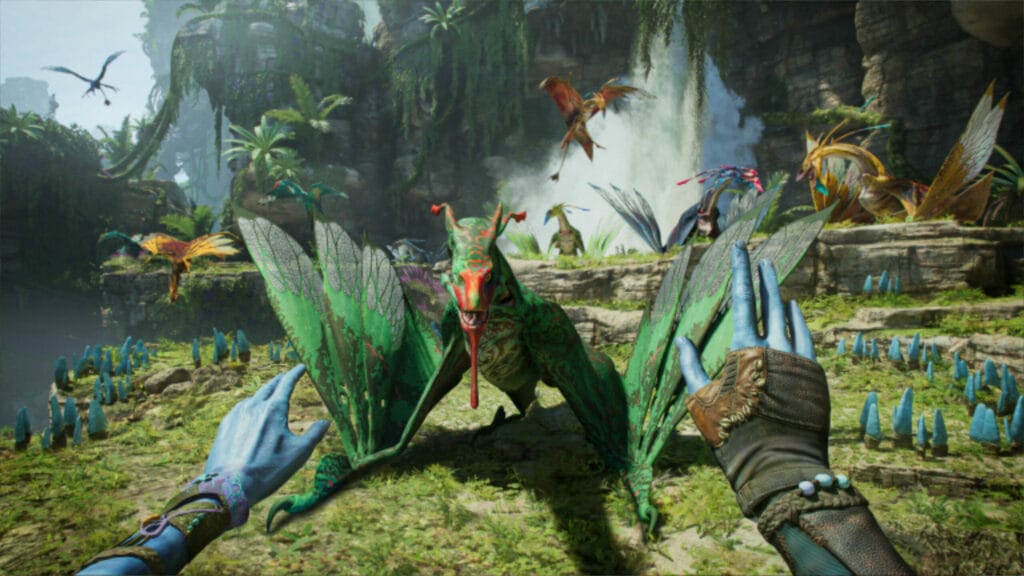
Beyond turning the sky into a warzone, players can also use their Ikran to travel across Pandora in style. There are three major biomes to explore in the game at release: Kinglor Forest, Upper Plains, and the Clouded Forest. Each of these biomes comes with their own unique aesthetic, fauna, and flora, and all of them are given equal time to shine during the story and the various side quests players can tackle. In true Ubisoft fashion, simply finding ancestor trees and unlocking new skills is not the only way to become stronger.
Defeating enemies, successfully clearing RDA bases, and having a go hunting and gathering, all reward players with experience and resources needed to craft better equipment. Aiding the various Na’Vi clans will also result in favour that can be spent to unlock better designs for gear or be traded for better gear outright. Furthermore, players can also cook their hard-earned food! Combining raw ingredients into mixpots can result in the strangest combinations, bestowing temporary buffs on players, while food that does not go together all that well will result in dishes simply not worth eating. As always, the Hunting Guide will hold any and all recipes players come across. Literally everything players do contributes in some way to level up. It is actually eerily reminiscent of The Elder Scrolls. Alas, as is the case with many role-playing games, this also means grinding out the final few skill points needed to max out the tree could potentially become extremely tedious.
The successful integration of the Avatar movie franchise into the gaming landscape is a feat all on its own, defying the common curse often plaguing movie tie-ins. The narrative seamlessly weaves the player into the rich lore of Pandora, offering a lengthy and epic 15-hour story masterfully expanding upon the cinematic universe. The balance between gameplay and narrative is skilfully achieved, allowing players the freedom to explore the captivating biomes of Pandora at their own pace. The incorporation of Na’vi heritage, from ancestor skills to the nuanced connection with wildlife, adds layers of depth and uniqueness to the gaming experience. The game goes beyond expectations with its aerial combat and traversal, offering an unprecedented sense of freedom in an open-world Ubisoft title. The Ikran mounts, coupled with well-designed controls, transform the skies into a dynamic battlefield, enhancing both exploration and combat. The game’s expansive skill tree, diverse biomes, and rewarding progression system contribute to its status as an essential gaming experience. There is so much to enjoy, and adore about this title.
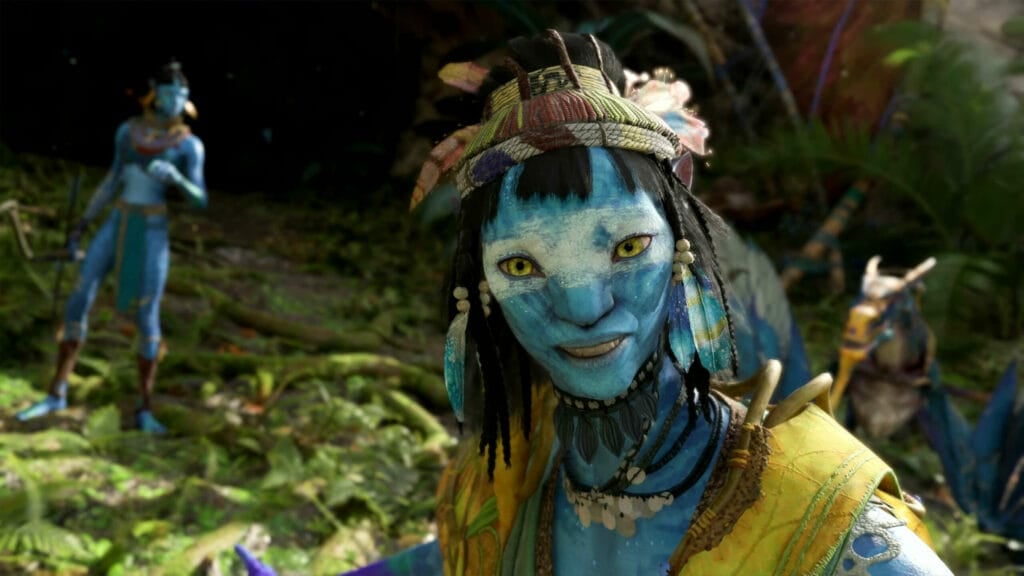
Avatar: Frontiers of Pandora more than lives up to the legacy of its cinematic counterpart. In fact, the title elevates itself to the ranks of exceptional and essential gaming – an incredible feat for a movie franchise tie-in. Ubisoft, often recognised for their prowess in open-world gameplay, absolutely exceeds expectations with this title. While its foundation may draw parallels to the Far Cry series, the game’s unique setting, narrative depth, and immersive gameplay set it apart as a groundbreaking experience.
Verdict:
EXCEPTIONAL
| PROS | CONS |
| Beautiful all-round | Exposition can be overwhelming |
| Epic continent-spanning story | Loading takes a while |
| Class-defining flying mechanics |
Title reviewed on Desktop PC (via Ubisoft Play) with code supplied by Ubisoft.
Review Methodology | Ethics Policy
Junior Editor at Vamers. From Superman to Ironman; Bill Rizer to Sam Fisher and everything in-between, Edward loves it all. He is a Bachelor of Arts student and English Major specialising in Language and Literature. He is an avid writer and casual social networker with a flare for all things tech related.







![Rainbow Six Siege Operation Deep Freeze [Hands On]](https://vamers.com/wp-content/uploads/2023/11/Vamers-Previews-Gaming-Operation-Deep-Freeze-03-218x150.jpg)

![Rainbow Six Siege Operation Heavy Mettle is Ram-tastic [Hands On]](https://vamers.com/wp-content/uploads/2023/08/Vamers-Gaming-R6S-Heavy-Mettle-01-218x150.jpg)



![Rainbow Six Siege Vector Glare continues the Year 7 promises [Hands-on Preview]](https://vamers.com/wp-content/uploads/2022/05/Vamers-Gaming-R6S-Vector-Glare-Banner-218x150.jpg)

![Preparing for Dawn of Ragnarok [Assassin’s Creed Valhalla Guide]](https://vamers.com/wp-content/uploads/2022/03/Vamers-Gaming-Preparing-for-Dawn-of-Ragnarok-Banner-alt-fixed-218x150.jpg)
![Rainbow Six Siege DemonVeil opens Year 7 with a barrier [Hands-on Preview]](https://vamers.com/wp-content/uploads/2022/02/Vamers-Gaming-Rainbow-Six-Siege-DemonVeil-Banner-218x150.jpg)


![Far Cry 5: Confess your sins and get lost in the bliss [REVIEW]](https://vamers.com/wp-content/uploads/2018/03/Vamers-Gaming-Reviews-Far-Cry-5-Confess-your-sins-and-get-lost-in-the-bliss-REVIEW-Banner-100x70.jpg)

